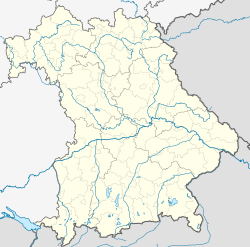History
In a district of Eitensheim, called "Breitenstückl", the grave of a man was found in 1998 – a farmer and who had died 7000 years before. Relicts which were also found there, are still 1000 years older. [3] Moreover, there were also findings from the Bronze Age, Hallstatt and La Tène period. Roman settlement was proved at the "Sebastianskapelle" and in the southeast of Eitensheim; grave mounds exist and there had been a villa rustica in the south of Eitensheim as well. [4]
Eitensheim, lying at the Roman trade street, belonged in the 8th century to the founded bishopric of Eichstätt as a basic village together with Möckenlohe, Buxheim and Adelschlag. [5] In 908 "Itensheim" had been first mentioned in the document of King Ludwig IV for the bishop of Eichstätt, called Erchanbald. Since then Eitensheim had been closely connected to the chapter of Eichstätt. In 1179, and again in 1186, two-thirds of the taxes of "Itensheim" had been confirmed to the chapter Eichstätt. The first lord of the village had been mentioned as ministerial of Eichstätt in 1122. [6] After a conflict Eitensheim had been adjudged completely to Eichstätt in 1305. [7] In the year 1460 Eitensheim was plundered by Ludwig the Rich during his war against the Earl of Ansbach and the Bishop of Eichstätt. [8]
At the end of the Holy Roman Empire the village consisted of 101 estates, most of them rural. After implementation of feeding, the number of animals had increased strongly in the princedom Eichstätt. In the 1790s, there had been only 350–400 horned cattle in Eitensheim. [9] Approximately 60 farms had to pay taxes to an office in Eichstätt and 5 farms had to pay taxes to the chapter of Eichstätt. Therefore, the different farms had to pay separately, but there was also a church, a manse, an early mass house, a school and other kinds of buildings.
In 1802 Eitensheim had come to the grand duke Ferdinand of Toscana. [10] In the new Kingdom Bavaria at 1806, there lived 546 persons, it had built an own assessment area and had been allocated to the provincial court Eichstätt since 1808/10. In 1817 Eitensheim was allocated to the provincial court Ingolstadt and in 1818 Eitensheim had become an independent commune with 124 families. [11] Since 1868 Eitensheim, lying on the railway track Ingolstadt–Treuchtlingen, has had its own stop. Today 180–200 trains run every day. [12]
In 1954 a central supply of water was installed and 1971 sewage was built. Two years before, in 1969, a school with gym was constructed, with part as primary school and part as secondary school. [13] Nowadays it is only a primary school and a new gym has been built.
Till the year 1972 Eitensheim had belonged to the rural district of Ingolstadt, now it belongs to Eichstätt. [12]
Moreover, Eitensheim builds an association of administrations together with Böhmfeld located in Eitensheim.

The University of Ingolstadt was founded in 1472 by Louis the Rich, the Duke of Bavaria at the time, and its first Chancellor was the Bishop of Eichstätt. It consisted of four faculties: theology, law, artes liberales and medicine, all of which were contained in the Hoheschule. The university was modeled after the University of Vienna. Its chief goal was the propagation of the Christian faith. The university closed in May 1800, by order of the Prince-elector Maximilian IV.
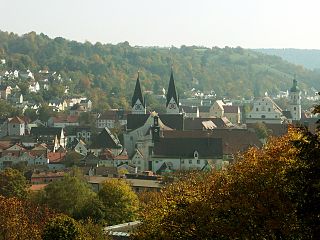
Eichstätt is a town in the federal state of Bavaria, Germany, and capital of the district of Eichstätt. It is located on the Altmühl river and has a population of around 13,000. Eichstätt is also the seat of the Roman Catholic Diocese of Eichstätt.
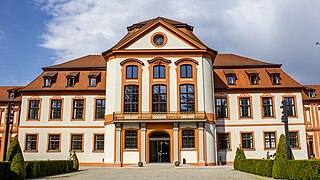
The Katholische Universität Eichstätt-Ingolstadt (KU) is a Roman Catholic research university in Eichstätt and Ingolstadt, Bavaria, Germany. It is the only Catholic university in Germany.

Magdalene of Bavaria was a German princess of the House of Wittelsbach who became Countess Palatine of Neuburg and Duchess of Jülich-Berg by marriage.
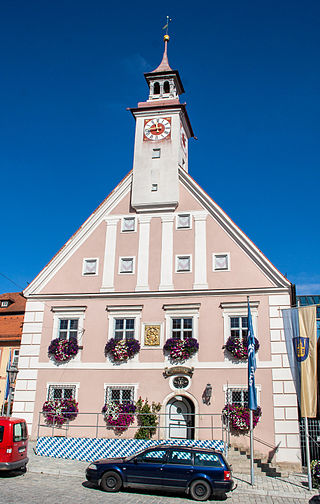
Greding is a town in the district of Roth, in Bavaria, Germany. It is situated 28 km southeast of Roth bei Nürnberg and 32 km north of Ingolstadt.

Arnschwang is a rural municipality in the district of Cham in Bavaria, Germany. The population was 2,004 as of the 2010 census. In recent years Arnschwang has focused on the production of environmentally friendly energy from biomass and water.

Petershausen is a municipality in the district of Dachau in Bavaria in Germany.

Johann Nepomuk Joseph Florian, Graf von Triva was a Bavarian General der Artillerie. He was the first War Minister of the Bavarian kingdom.
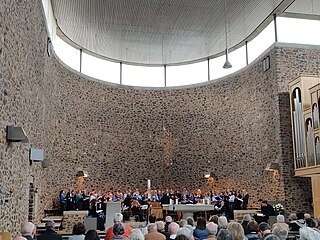
St. Martin is the name of a Catholic parish and church in Idstein, Rheingau-Taunus-Kreis, Germany. The official name of the church is Katholische Pfarrkirche St. Martin. The name of the parish became St. Martin Idsteiner Land on 1 January 2017, when it was merged with five other parishes. The parish is part of the Diocese of Limburg.

The Munich–Treuchtlingen railway, also known as the Altmühlbahn, is a railway line in the German state of Bavaria. As part of the new and upgraded Nuremberg–Ingolstadt–Munich line project, the Munich-Ingolstadt section is gradually being upgraded for a line speed of up to 200 km/h (120 mph).
Heinrich II von Rotteneck was prince-bishop of Regensburg from 1277 to 1296.

The Willibaldsburg is a spur castle, built around the year 1353, in Eichstätt in Upper Bavaria. Until the middle of the 18th century, it was the representative castle and seat of Eichstätt's prince-bishops.

St. Valentin is the common name for the Catholic parish church and Basilica minor Basilica of SS Dionysius and Valentinus in Kiedrich in the Rheingau, in Hesse, Germany. It was built at the end of the 15th century in the Gothic style. Its organ is one of the oldest playable organs in Germany. The church was a pilgrimage destination for people with epilepsy and therefore has notable carved wooden laity stalls, including one decorated with the "Gerechtigkeitsspirale".

Neustadt am Main Abbey was an abbey of the Benedictine Order in Neustadt am Main, Bavaria, Germany. It existed from the 8th century until the dissolution of abbeys in the course of secularization in 1803. During its heyday in the early Middle Ages, the abbey was a political power that vied for regional influence with the Prince-bishops of Würzburg, the Archbishops of Mainz and the Counts of Rieneck. Today its location is occupied by a monastery operated by the nuns of the "Dominican Order of Saint Catherine of Siena", also known as Kloster Neustadt. The former abbey church today serves as the Catholic parish church for Neustadt.
Burgellern Castle is a castle located in a village called “Burgellern” near Bamberg in Franconia, Germany. The former residence of Bamberg's cathedral chapter of the 18th century is today offering a Hotel and a Restaurant.
Pfünz Roman Fort, Castra Vetoniana or Vetonianae, was a Roman cohort camp near Pfünz, a village in the municipality of Walting in the county of Eichstätt, Bavaria. It was built in about 90 A. D. on a 42-metre-high Jurassic hillspur between the valley of the Altmühl and that of the Pfünzer Bach stream. it is a component of the Rhaetian Limes which was elevated in 2005 to the status of a UNESCO World Heritage Site. Of historical importance are the remains of the double V-shaped ditches hewn out of the rock in front of the position, the one on the western rampart being the best preserved. In 1998, as part of the construction of a high pressure water system, the Bavarian State Office for Monument Protection carried out further test excavations. The archaeological record and rich finds from Pfünz, some of which are very rare, are seen as reasons for further studies in the future.

Schwarzenholz is the second largest district of the municipality of Saarwellingen in Saarland, Germany.

Johann Konrad von Gemmingen (1561−1612) was Prince bishop of Roman Catholic Diocese of Eichstätt in Bavaria. The bishop was an enthusiastic botanist who derived great pleasure from his garden, which rivaled Hortus Botanicus Leiden among early European botanical gardens outside Italy.
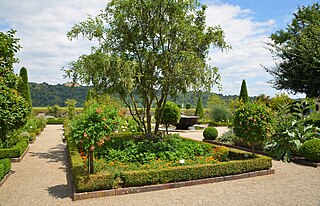
The Eichstätter Garten or Hortus Eystettensis, also known as the Bastionsgarten was a botanical garden that was created during the Renaissance period under Prince-Bishop Johann Konrad von Gemmingen on the bastions of the Willibaldsburg in Eichstätt, Upper Bavaria. The plants in the garden were described in the magnificent botanical work Hortus Eystettensis, which was first published in 1613 on behalf of the Prince-Bishop.

Sankt Georgen is an 18th-century planned new town, today a district of the city of Bayreuth in Bavaria.




